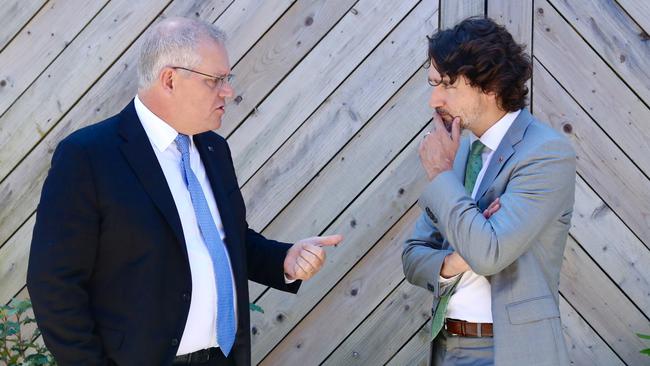Scott Morrison used G7 to showcase our green strength
Armed with figures on greenhouse gas emissions reductions, Scott Morrison ‘took every opportunity’ to defend Australia’s climate change policy.

Scott Morrison “took every opportunity” at the world leaders’ meeting in Cornwall to defend Australia’s climate change policy, basing his argument on an analysis showing that every G7 member was lagging behind Australia by three to five times on the way to reaching their 2030 carbon emissions reduction targets.
Armed with figures on greenhouse gas emissions reductions between 2005 and 2019 and the estimated annual cut required to reach 2030 targets, the Prime Minister promoted Australia’s relative success in cutting emissions by using technology.
The analysis, based on UN and Department of Industry, Science, Energy and Resources figures, shows Australia’s annual change in emissions, up to 2020, was a 1.3 per cent cut with a forecast necessary annual cut to meet the 2030 target of just 0.9 per cent.
But Canada’s annual change to 2019 has been a fall of just 0.1 per cent and the G7 member requires an annual cut in greenhouse gas emissions of between 3.6 and 4 per cent to meet its 2030 reduction targets – four to five times the cut needed for Australia.
According to the analysis, the UK and the US both had huge drops in emissions between 2005 and 2019 – 34 per cent and 13 per cent respectively – but both require an annual cut of 3.9 per cent to reach the 2030 target.
The remaining G7 members – Italy, France, Germany and Japan – all had big initial drops in emissions between 2005 and 2019 but now need annual cuts in carbon emissions of up to 3.3 per cent to meet their 2030 targets – three times the forecast for Australia.
Boris Johnson, as G7 host, said at a press conference with Mr Morrison that the UK had cut emissions fast initially by reducing coal-fired power from 40 per cent to just 2 per cent since 2012.
“It can happen fast,” he said.
The G7 communique on climate change said member countries had to accelerate efforts to meet 2030 targets and would aim to “cut our collective emissions by around half compared to 2010”.
The communique also said that to be “credible”, the stated targets “need to be supported by tangible actions in all sectors”.
“We will need a technology-driven transition to net-zero,” the communique said.
The British Prime Minister said he understood how difficult the aim of reducing carbon emissions was for Australia as a major coal exporter, and was “impressed by the ambition of Australia”.
Mr Johnson said the G7 members understood “the situation Australia is in; it’s a massive coal producer – it’s having to change the way things are orientated, and everyone understands that”.
“We want to work with Scott, with Australia, on the cleantech solutions. Because what we both strongly believe is you can have a green industrial revolution that drives high-wage, high-skilled jobs. You can do both,” he said.
Energy and Emissions Minister Angus Taylor said the G7 was “an important opportunity for Australia to demonstrate how our technology-first approach will see Australia meet and beat our emissions reduction commitments while continuing to grow our economy and export industries”.
Mr Taylor told The Australian on Wednesday that working with international partners was key to finding the solutions to the world’s climate challenges while also protecting jobs.




To join the conversation, please log in. Don't have an account? Register
Join the conversation, you are commenting as Logout